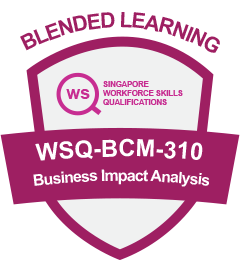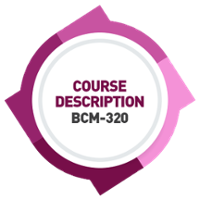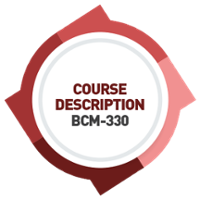Business Impact Analysis
![]() At this stage, you are about to attend the second portion of the WSQ BCM workshop, which is organised in-house. The course code is BCM-310.
At this stage, you are about to attend the second portion of the WSQ BCM workshop, which is organised in-house. The course code is BCM-310.
This first half-day online session, or Module 1 Session 2 for Blended Learning, "Business Impact Analysis," will be conducted after completing the "Risk Analysis and Review" module.
Again, it may be helpful if you have not read the first two articles regarding how this project started. You may want to read "[1A] Starting the Project" and "[1B] Developing BCM Structure and Framework." Note that [1A] and [1B] are not part of the WSQ BCM course and will be billed separately.
 This article is the fourth part of the "WSQ Funded BCM Project" series. This is the reading for participants embarking on a BCM implementation using a combination of training with SkillsFuture Singapore (SSG) funding from the Singapore government and consulting to develop, implement and finalize its BCM program for an organisation.
This article is the fourth part of the "WSQ Funded BCM Project" series. This is the reading for participants embarking on a BCM implementation using a combination of training with SkillsFuture Singapore (SSG) funding from the Singapore government and consulting to develop, implement and finalize its BCM program for an organisation.
 Business impact analysis, or BIA, is analysing the effects of interruptions on business functions and the organisation as a whole. Based on the severity of these effects, the Organisation's BCM Coordinator can infer the relative recovery priorities of these business functions.
Business impact analysis, or BIA, is analysing the effects of interruptions on business functions and the organisation as a whole. Based on the severity of these effects, the Organisation's BCM Coordinator can infer the relative recovery priorities of these business functions.

The process of conducting the "Business Impact Analysis" or "BIA" in the WSQ-based BCM Project is as follows:
1. Workshop [Online]
 A workshop is conducted to guide business unit BCM coordinators to collect data on:
A workshop is conducted to guide business unit BCM coordinators to collect data on:
- Critical business functions (CBFs),
- Potential impacts of a prolonged disruption of CBFs
- Time Periods within which the CBFs must be recovered to minimize losses
- Key dependencies to perform CBFs
- Resources necessary to perform CBFs
Since this is an online workshop, participants will undergo an E-Learning program a week before a Zoom session with the instructor. This will give them the necessary information and context to understand some key concepts involved in Business Impact Analysis before the workshop session.
 What participants should do for the Online Workshop:
What participants should do for the Online Workshop:
- Participants are encouraged to read the email supplementary materials before the workshop
- The soft copy BIA templates should be downloaded from the same E-Learning portal
- Participants should complete the E-Learning Module and begin filling in their templates
- Participants should then submit their completed templates
It is important to note that because the workshop is a one-time group event, participants should lock this event in their calendars. No repeat workshop will be conducted for absent participants, and SkillsFuture Singapore or SSG may not approve the course subsidy if the participant is absent for more than 75% of the module.
2. Consultation & Assessment [Online]
.png?width=300&name=BL-B-3%20Run2%20ZOOM%20-%20Copy%20(2).png) After the workshop, participants will have one week to complete and submit the templates to their organisation's BCM Coordinator, who will consolidate the templates and send the batch to the consultant.
After the workshop, participants will have one week to complete and submit the templates to their organisation's BCM Coordinator, who will consolidate the templates and send the batch to the consultant.
A consultation and assessment session (approximately 30 minutes) has been arranged for individual departments to go through the templates with the consultants and sit for a simple open-book assessment comprising a few easy-to-answer questions. This assessment is a requirement from SSG to qualify for government funding.
Zoom will be used to facilitate the assessment between consultants and participants.
What participants should do for the online class:
- Submit the BIA templates to the E-learning Portal on time
- Comments will be sent via the E-Learning Portal before the consultation/assessment session. Participants are expected to edit their BIA template before the session.
- Review your templates before the consultation/assessment session and quickly read through the course materials.
- Attend the consultation/assessment session at the appointed time (On Zoom)
- Re-submit the final, revised template to the E-learning Portal
The consultant will process the templates from all departments and write a report for submission to the organisation's management.
3. RAR & BIA Presentation
.jpeg?width=300&name=Senior%20Management%20Briefing%20(2).jpeg) At this juncture, it is appropriate to update senior management on the project's progress and present the interim findings of the RAR and BIA.
At this juncture, it is appropriate to update senior management on the project's progress and present the interim findings of the RAR and BIA.
Once the findings are endorsed, the reports are finalised and submitted.
What senior management should do:
- Review the key risks for the organization (RAR)
- Review the list of critical business functions and their recovery time objectives (BIA)
- Endorse the findings.
Henceforth, the business continuity strategy (BCS) and plan development (PD) phases will be developed based on these endorsed findings during the next two phases.
We will enter the Business Continuity Strategy phase of the project only after management endorses the RAR and BIA findings.
4. Public WSQ Course
One challenge to maintaining this program's competency is training newly appointed business unit BCM coordinators when they replace the incumbent.
The newly appointed officer can undergo the same training and bring his/her current templates to the public course offered by BCM Institute. Just make the advanced arrangement with the program administration officer.
If you are attending a public WSQ course, this course is similar to the afternoon session for the WSQ-BCM-310 (Course code), titled "Assessing Risk and Business Impact Requirements."
5. Next Step
Once this session is completed, you are ready to attend the second one-day WSQ course, "Developing Business Continuity Strategies and Plans." The course code is WSQ-BCM-320. Read more about the expectations for the next half-day workshop, "Evaluating the Business Continuity Strategy."


![[BL] [2] [RAR] WSQ Funded BCM Training and Project: Running the Risk Assessment](https://no-cache.hubspot.com/cta/default/3893111/b8cae5c7-407e-46e1-8ab7-e1dc0d1d6dd9.png)
![[BL] [3] [BIA]: WSQ Funded BCM Training and Project: Executing the Business Impact Analysis](https://no-cache.hubspot.com/cta/default/3893111/5ad02a1f-0b6e-4b06-a285-036955b14572.png)
![[BL] [4] [BCS] WSQ Funded BCM Training and Project: Evaluating the Business Continuity Strategy](https://no-cache.hubspot.com/cta/default/3893111/f1eca023-b7b6-4efd-b7c2-bb5301b3845e.png)
![[BL] [5] [PD] WSQ Funded BCM Training and Project: Implementing the Business Continuity Plan](https://no-cache.hubspot.com/cta/default/3893111/f83c215b-a30e-4620-8dbf-de639267f5f3.png)
![[BL] [6] [TE] WSQ Funded BCM Training and Project: Executing Tests and Exercises](https://no-cache.hubspot.com/cta/default/3893111/59457891-68bd-4e23-ab1e-44d793c03e28.png)







